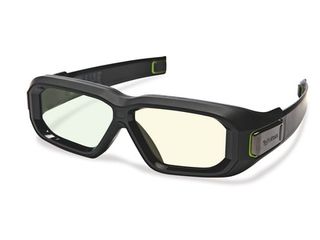Why you can trust TechRadar
Other than the size, the Nvidia 3D Vision 2 Wireless Glasses are almost identical to the original 3D Vision glasses, which unfortunately means they're still uncomfortable.
Samsung's SSG-2100AB specs are still the most comfortable we've perched on our conks, and Nvidia lags well behind in this department. It's odd because they've obviously been redesigned with comfort in mind, but still don't sit naturally on the face.

Now the good news - the bigger lenses and wraparound design of the Nvidia 3D Vision 2 glasses greatly improve your viewing experience.
Having your brain decode stereoscopic 3D images while also dealing with, y'know, real life 3D in your peripheral vision is very tiring, and we suspect closely linked to those inevitable headaches following a long session.
Increasing the lens size is such a simple solution to this problem, it makes you wonder why it took them this long to get it sorted - so it goes with 'new' technologies, we suppose.
The really important development here is LightBoost, Nvidia's new 3D tech.
To you and us, this is a layer of film across monitor and TV screens that counteracts any dimness, delivering twice the brightness and, consequently, clearer, more colourful 3D images.
Sounds a bit like marketing nonsense, but we can absolutely vouch for it - just read our review of the LightBoost-ready Asus VG278H if you need convincing.
Verdict
These Nvidia 3D Vision 2 glasses are being marketed as LightBoost-compatible, but the same is true of the 3D Vision 1. They're both just shutter glasses, after all.
Buy these glasses for the improved viewing experience, by all means, but don't be tricked into thinking you can't enjoy LightBoost without them.
We liked
Nvidia has made good progress with the 3D Vision 2 glasses, by eliminating peripheral vision problems and increasing lens size. It's subtle, but it really does make a difference.
We disliked
That progress is halted in the comfort department, though. Given that these glasses are selling for roughly the same as a pair of (non-3D) prescription glasses, we expect a greater level of comfort. Competitors like Samsung are some way ahead in this area.
Final verdict
Crucially, the combination of these glasses with a LightBoost-equipped PC monitor gave us our first genuinely enjoyable, almost jaw-dropping 3D gaming experience - for the first time, we're excited about 3D.

Ad creative by day, wandering mystic of 90s gaming folklore by moonlight, freelance contributor Phil started writing about games during the late Byzantine Empire era. Since then he’s picked up bylines for The Guardian, Rolling Stone, IGN, USA Today, Eurogamer, PC Gamer, VG247, Edge, Gazetta Dello Sport, Computerbild, Rock Paper Shotgun, Official PlayStation Magazine, Official Xbox Magaine, CVG, Games Master, TrustedReviews, Green Man Gaming, and a few others but he doesn’t want to bore you with too many. Won a GMA once.
